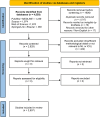Trends and methods in intensive care unit (ICU) research using machine learning: latent dirichlet allocation (LDA)-based thematic literature review
- PMID: 40731277
- PMCID: PMC12308941
- DOI: 10.1186/s12911-025-03132-2
Trends and methods in intensive care unit (ICU) research using machine learning: latent dirichlet allocation (LDA)-based thematic literature review
Abstract
Introduction: The use of machine learning (ML) in intensive care units (ICUs) has led to a large yet fragmented body of literature. It is imperative to conduct a systematic analysis and synthesis of this research to identify methodological trends, clinical applications, and knowledge deficits.
Methods: A systematic literature review was conducted in accordance with the PRISMA guidelines, encompassing 2,507 ICU-focused ML publications from 2019 to 2024. Latent Dirichlet Allocation (LDA), an unsupervised topic modeling approach, was used with n-gram and no-n-gram tokenization strategies. Bayesian optimization approaches were used to increase model coherence and diversity.
Results: The analysis demonstrated a substantial degree of methodological variability, emphasizing the predominance of studies on infection surveillance and complication prediction. N-gram tokenization efficiently identified clinically specific topics, but no-n-gram techniques produced larger interpretative groups. Underexplored fields include emerging research areas like drug response prediction, pediatric-specific modeling, and surgical risk classification.
Conclusion: In conclusion, the study highlights the significance of methodological transparency and tokenization strategies while offering a thorough topic overview and identifying methodological trends in the literature on ICU - ML. Future research should prioritize neglected areas such as pediatric care modeling and therapy response, utilizing advanced ML techniques and multimodal data integration to enhance the outcomes of ICU patients.
Keywords: Clinical applications; Intensive care unit; Latent dirichlet allocation; Literature review; Machine learning; Topic modeling; Unsupervised modeling.
© 2025. The Author(s).
Conflict of interest statement
Declarations. Ethics approval and consent to participate: Not applicable. Consent for publication: Not applicable. Competing interests: The authors declare no competing interests.
Figures










Similar articles
-
The Use of Machine Learning for Analyzing Real-World Data in Disease Prediction and Management: Systematic Review.JMIR Med Inform. 2025 Jun 19;13:e68898. doi: 10.2196/68898. JMIR Med Inform. 2025. PMID: 40537090 Free PMC article.
-
Comparing Open-Access Database and Traditional Intensive Care Studies Using Machine Learning: Bibliometric Analysis Study.J Med Internet Res. 2024 Apr 17;26:e48330. doi: 10.2196/48330. J Med Internet Res. 2024. PMID: 38630522 Free PMC article.
-
[Volume and health outcomes: evidence from systematic reviews and from evaluation of Italian hospital data].Epidemiol Prev. 2013 Mar-Jun;37(2-3 Suppl 2):1-100. Epidemiol Prev. 2013. PMID: 23851286 Italian.
-
Home treatment for mental health problems: a systematic review.Health Technol Assess. 2001;5(15):1-139. doi: 10.3310/hta5150. Health Technol Assess. 2001. PMID: 11532236
-
Implementation strategies for WHO guidelines to prevent, detect, and treat postpartum hemorrhage.Cochrane Database Syst Rev. 2025 Feb 26;2(2):CD016223. doi: 10.1002/14651858.CD016223. Cochrane Database Syst Rev. 2025. PMID: 40008632 Free PMC article.
References
-
- Society of Critical Care Medicine. Critical Care Statistics 2023 [Available from: https://sccm.org/communications/critical-care-statistics
-
- European Centre for Disease Prevention and Control. Incidence and attributable mortality of healthcare-associated infections in intensive care units in Europe, 2008–2012. Stockholm; 2018.
-
- Blei DM, Ng AY, Jordan MI. Latent dirichlet allocation. J Mach Learn Res. 2003;3(null):993–1022.
Publication types
MeSH terms
LinkOut - more resources
Full Text Sources

